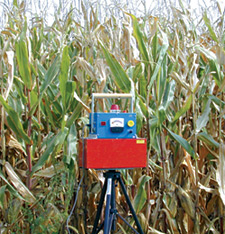 |
|
Photo: Butch Hartman, Fermilab |
Safety critters monitor lab site
The instrumentation team of Fermilab's Environment, Safety & Health Section is the caretaker of a unique menagerie: albatrosses, chipmunks, hippos, pterodactyls, scarecrows, and an aardvark to name a few. These critters are radiation detection instruments, designed and built in-house. "Everyone here knows what they are, but no one else in the world would," says Butch Hartman, team co-leader.
The level of radiation at Fermilab is stringently monitored, and radiation at Fermilab consistently falls below radiation standards set by the US Department of Energy. Throughout the site, radiation levels are maintained at the normal, background levels found in the natural environment; higher levels are found only inside accelerator enclosures and at a few posted, fenced-off locations. Workers who enter experimental areas that might be exposed to measurable levels of radiation wear detection badges. The majority of radiation exposure occurs when accelerator components need repair; the maintenance inside accelerator enclosures, of course, is always done after the beam is turned off. For an extra level of safety, Fermilab policy mandates that workers in radiological areas may only be exposed to levels that are less than one-third of the annual limit allowed by the DOE for radiological workers.
As part of Fermilab's careful monitoring program, the radiation detection "critters" keep a watch on radiation levels throughout the lab's acceler-ator complex and beyond. The origin of the instrument names is often part of lab lore.
In one legend, an employee working in frustration on a radiation instrument in the late 1960s dubbed his instrument the "albatross," alluding to the poem The Rime of the Ancient Mariner and the sailor who wears an albatross around his neck as a burden. The "scarecrow," an instrument mounted on a tripod (left), would—if it detected unacceptable levels of radiation in an area—warn people to stay out of the area, like crows warned to stay out of a cornfield. A piece of hardware called the "aardvark" collects little, termite-like bits of radiation data and has a long, protruding trunk-line. The "chipmunk" makes a chirping sound, and "hippos" are rotund and gray.
The stories behind some of the names have been lost. The "pterodactyls"? "I really don't know how they were named," says John Larson, team co-leader. "But it's a conversation starter; it's not boring. You get tired of hearing acronyms all the time."
D. A. Venton
Click here to download the pdf version of this article.






